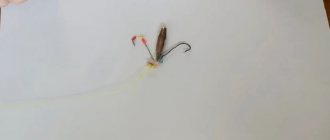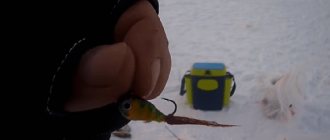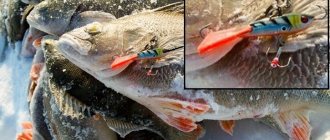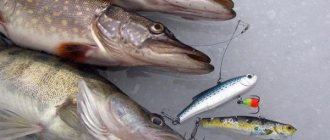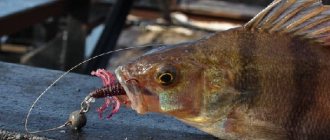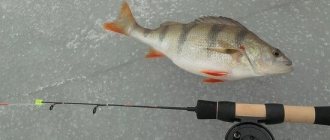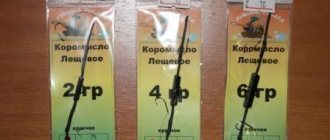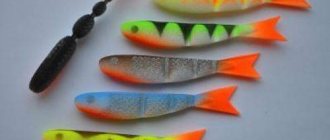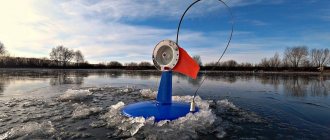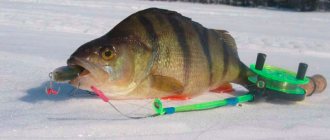Fishermen are creative and imaginative people. It’s impossible to count how many unusual fishing methods and baits they have come up with. “Balda” is one of these unusual baits. It is not known for certain when and where this bait first appeared. The Urals, Siberians, and fishermen from the Moscow region are fighting for the palm. Only one thing is known - the bulldozer is a common bait that has its loyal fans in different regions.
In winter fishing, the balda is known as one of the most effective gear for catching perch. They also successfully catch pike perch with it, and in some places large roach and bream.
What is a fishing rod
The bulldozer is an elongated weight with a thickening or expansion at the bottom, in the narrow part of which there is a transverse hole. A piece of thick and rigid fishing line is passed into the hole, onto which two free-hanging hooks are attached on either side of the weight. The hooks are positioned so that the tip points away from the weight. The fishing line is tied into a knot at the top, as a result of which there is a weight and hooks on the ring of fishing line that move freely along it.
The entire structure is tied to the main fishing line. Often, for ease of installation, a loop of fishing line is tied to winding rings or double-sided swivels. With short swings of the fishing rod and knocking the weight on the bottom, the free-hanging hooks move up and down along the line, attracting fish and provoking it to bite. A weight knocking on the ground raises a cloud of turbidity and imitates an insect or fish swarming at the bottom, and hooks falling down represent larvae raised from the bottom. When the bite is good, it happens that perches sit on both hooks at once .
Main elements of bait
Design features
The appearance and play of the bully resemble a beetle swarming in the bottom, which attracts fish so much. A lead cone is used as a sinker. Since the purpose of fishing is perch, it makes no sense to use more expensive metals. At the top of the figure there is an eyelet through which a fishing line up to 0.2 mm thick is passed. Hooks are mounted on both sides; the fore-end should be long, making it easier to remove them from the fish’s mouth. Beads of any color must be attached to it, repeating the colors of various insects.
Small red balls are often used, imitating bloodworms - the main food supply of the striped predator. The sinker plays the main role in attracting it; it has an elongated shape with a flat bottom, but there are models similar to small spinners. As a rule, they are made by hand, at home. Standard bait can be bought at the store.
Varieties of bait
Balda for catching perch differs in size and weight of weights. The body of the weight has a length from 1 to 5, and sometimes 7 centimeters. Accordingly, the mass of such cargo differs. The use of one size or another is often determined by the fishing location: depth and presence of current. The shape of the load is in the form of a bullet, pear, elongated bell or cylinder, but most often in the shape of a truncated cone. The wider and heavier part of the sinker is at the bottom point, thanks to this, when playing, the weight does not fall to one side and the hooks play freely.
The debate about whether it is necessary to paint weights and how this affects the bite continues. Most anglers are inclined to think that this is secondary. However, they are often painted red, black or green and combinations thereof. Unpainted weights made of stainless steel, brass or lead are also used.
The equipment of the hooks is of greater importance. Beads, beads, cambrics are put on them, and sometimes the forend is wrapped with thread. In general, the hook is equipped with elements in various combinations that attract fish. The shank of the hook can be filled with beads over the entire length or have one bead. There is no recipe for what is best. On the same body of water, even during the day, the preferences of perch change. Therefore, those who constantly catch perch on the bait have a whole arsenal of baits in different versions and change them during the fishing process. Preferred solutions can only be found based on experience.
It’s good when there are different types of bait and you can experiment
The fishing line used for the loop is rigid and thick, with a diameter of 0.2 - 0.5 mm. This loop does not stretch into one line, does not twist, and ensures free movement of the hooks. Fluorocarbon, which has the necessary characteristics, is often used.
Features and secrets
- You can catch a perch on a balda in other ways of playing. If the fish does not take the classic movements, then we try to move the hooks (by carefully tensioning and loosening the fishing line, as well as in different directions), without lifting the sinker from the bottom. This technique works well for passive fish in the dead of winter.
- In addition, we use various variants of jig play - trembling at the bottom, jerky micro-lifts, slow even rises and drops with trembling. If there is a perch under the hole, then after selecting the right game, you can get the whole flock out from under the ice.
- A noise bait works well for an active predator. To make it, a cavity is cut out in the body of the sinker and filled with balls (bearings), then sealed. When falling and shaking, such a bait will make noise and tapping noises, which attract the striped robber.
Subscribe to the channel:
My YouTube channel RYBAFAN on fishing:
We're OK
Why is bait good?
Balda, like any non-standard bait, often catches perch when it doesn’t bite on anything else. Moreover, really large perch can be caught with it. Apparently, this is due to the fact that a seasoned humpback is already able to take something away from someone, regardless of those from whom he takes it. Moreover, this happens when he is not particularly active in order to grab balancers or spinners, and jigs are of little interest to him.
Pike or even grayling may be tempted by such bait.
As already mentioned, the bulldozer is good in currents and depths, that is, where humpback whales like to stand.
We recommend reading
How to catch perch with a pyzdrik in winter and make a rig The pyzdrik is a bait that is not familiar to everyone, but it works great for perch.
Catching zander from a boat
The right time for such an action is autumn. As you know, pike perch begins to actively peck when it gets colder. An interesting way to catch it is fishing with a bullhead. When the water cools, fishermen set out on boats in search of the “fanged one.” The gear must be set up in advance so as not to waste precious time. For vertical fishing you will need a side rod up to a meter long. As a guard, a nod is mounted on the end of the whip. The pike perch bait differs from the perch model. The metal for the sinker must be heavier in order to give a ringing blow. Tungsten is better suited for these purposes, whose only drawback is the price.
To learn more:
Fishing line net: fine for violating the law
You can fish both in still waters and on the current. The method is popular on large rivers - Don, Ural or Volga. In small rivers of Bashkiria it is also used for grayling. Along with vertical lures, catching pike perch or pike perch on a pole from a boat brings good results. It is more specialized, so other fish are rarely present in the bycatch. Single catches may include pike, and peaceful ones may include roach.
How to make a balda yourself
Balda is made independently by those who have accumulated experience in its use, and they already know what exactly they want from the bait. Experienced fishermen are sure that homemade bait is more effective than purchased bait.
Elements for making your own bulldozer
Preparing the weight
The simplest weight is made of lead, and for this it is not necessary to engage in casting. Take a sliding sinker weighing 5–20 grams, like an olive, flatten one side with a hammer, and make a transverse hole on the other side with a thin drill to allow the fishing line to pass through. One narrow end can be sawed off to widen the body of the sinker. A cone sinker is suitable; they are available in different weights. Saw off or bite off the top ring or swivel with pliers and drill a hole. If there is a suitable material - brass or stainless steel rods, then weights are made from them. True, this path is longer and more difficult, since hard materials require serious processing due to the need to use certain tools.
You can use a perch spoon as a load, but you need to “bite off” the hook with pliers first. The weight of the weight depends on the depth where the fishing will take place.
What should the hooks be like?
The main requirement for hooks is the presence of a wide eye. With a standard eye size, even if it seems that the hook slides freely, the bait will not work clearly. Such hooks in the water begin to “stick” to the fishing line and do not come down when playing. You don’t have to go too small with the size of the hooks; perch is not picky in this regard, but a large hook detects fish better. Hooks numbered 5 are suitable for equipping a bulldozer .
Assembling equipment step by step
Once the sinker and suitable hooks have appeared, take a piece of rigid fishing line. The first hook is threaded onto the fishing line, then the weight, then the second hook. When you lift the ends of the fishing line up, it turns out that the weight hangs in the middle, the hooks are on the side with the stings directed away from the weight. Some fishermen add one or two beads or beads on top of the hooks on the fishing line, which also move freely along the fishing line along with the hooks when playing.
Use thicker fishing line so that the hooks “walk” along it better. Diameter 0.20 mm. The main line is already 0.16-0.18 mm.
The ends of the fishing line are tied to a ring, or better yet, a swivel. This will allow you to conveniently tie the main line later. The size of the loop varies, depending on the weight and length of the weight, the size of the hooks, and the preferences of the angler. But more often there are rings with a diameter of 2–5 cm. A smaller diameter will not give the hooks freedom to play; a larger one, in principle, is possible.
We recommend reading
Which winter fishing line to choose for perch How to choose the right fishing line for perch fishing in winter, and what you need to know when choosing.
Making a bulldozer for catching perch and other fish: photos and videos
Balda is one of the baits that is easier and cheaper to make with your own hands than to buy. Minimum components, tools and skills required. It is also worth noting that homemade ones almost always catch better than stock baits and tackle.
To make classic tackle we will need:
- a weight (olive, pellet, pear, cylinder, trapezoid, etc.) can be with or without a molded-in or hanging hook;
- fishing line;
- two single hooks with a wide eye (type Ovner S59);
- beads, seed beads, cambrics, lurix, artificial bloodworms and other additives;
- a swivel and an additional hook of a smaller size if you plan to knit an additional “lure” above the main bait;
- awl, pliers/drill.
We take a weight of the shape we like (the main thing is that it is symmetrical relative to the axis) and make a 3-4 mm hole in it on the narrow part with an awl or a thin drill. We process the hole with a thin file or zero-grit sandpaper to avoid burrs and burrs.
Good to know. Lead and tin are soft and easy to make holes in with an awl. It is better to take brass, bronze or tungsten weights either ready-made, or process them with a drill using a vice.
Then the hooks are taken so that the length of the fore-end is less than the length of the weight (by about a quarter). They are decorated with beads, cambrics and beads - this element acts as an imitation of bait.
We decorate the hooks for the bulldozer with cambrics. In this case, the basis of the bulldozer is a vertical perch spoon
Next, the hook is threaded into the fishing line with the hook hooked outward, then the weight, then the hook with the hook hooked outward.
Balda with a driven weight is a good option for perch, done in 5 minutes
A loop is knitted on top (size from 2 to 10 cm depending on the size of the bulldozer). This loop length is optimal for playing hooks. Fluorocarbon with a diameter of 0.2-0.28 mm is used. Knots - figure eight, Rapalovsky.
Decoration on hooks - beads of various colors
Balda with beads on hooks
Additionally, you can place a floating hook framed with cambric or beads 10-15 centimeters above the Ural egg. More details about the implementation in the video - a homemade bulldozer for catching perch with a secret:
Details about the installation of the bulldozer:
Advice! It is best to attach all the equipment to the main line using a small fastener. This will allow you to quickly change from one fishing rod to another, which were previously tied at home.
What fishing rod should I use for fishing?
Winter fishing rods with long whip
To catch perch in the winter on the boulder, fishing rods with long whips are used, allowing you to make clear strokes. Some fishermen fish without nods, however, its use is desirable, since the perch sometimes takes it quite delicately and there is a high probability of missing a bite.
Use a nipple or mylar nod, which has good shock absorption.
Perch fishing technique
The technique of fishing with a bulldozer is simple. Unwinding the fishing line, the fisherman finds the bottom with a weight. After this, the slack is removed so as to feel that the load is standing upright, but has not yet come off the bottom. This is followed by a short stroke of the brush and the bait sharply returns to its place, but again so that the load does not fall on its side. In order to control this moment, a nod is precisely what is needed. After a pause of 5–20 seconds, the next swing follows, and so on. The bite, as a rule, follows a pause, and often after several seconds. And the more passive the fish, the more pauses are made.
We recommend reading
Catching perch in winter with a reelless reel and rating the best models Both a professional and a novice angler can catch perch on the first ice.
This striped robber also lives in reservoirs...
Fishing tactics
There are no special tactics for winter fishing for perch on the bald. General principles and approaches to searching for striped predators in winter are used. The predator's stopping places depend on the winter period and the conditions of the reservoir. Periods of activity are replaced by a passive state. The general rule is an active search, drilling holes at a distance of 10-15 meters, and when a cool place is found, more frequent drilling of the water area. Read more about tactics for finding winter perch in the article:
You can catch perch on a balda in winter during all periods of freezing. In terms of the first and last ice, this decoy is completely unrivaled. Perch in the middle of nowhere also responds well to this bait. At this time, the number of bites increases significantly if you place a provocateur fly 20 centimeters higher (preferably in a sliding version).
An important criterion for the success of catching fish with eggs is the correct choice of place. The main attracting factor is the rise of a cloud of turbidity when tapping on the bottom. This attracts striped fish from afar. Therefore, a soft bottom with sediment, sand, and clay is suitable for fishing with a cannon. On a hard rocky bottom, this bait often does not work for perch, but in such places, tapping attracts burbot.
Sometimes the predator takes it in the water column. A type of bait is the Ural bully. This is a regular vertical spoon, equipped with free-moving hooks in the upper part.
Ural bully
What kind of tackle is a “bulda”?
When fishing for perch on a bulldozer, you use a short fishing rod, the end of which is reinforced with hard material, which helps you play the bait in the right directions. A soft nod on the rod in the form of a silicone tube registers the moment when the rod touches the bottom and records the bite.
When using one tool, but at different depths of water, it is equipped with a device for winding and unwinding fishing line onto a plastic reel. You can build a boom yourself; this tackle is simple in design and does not require special skill to install the elements.
Materials are selected from household items or purchased at a retail outlet:
- the lead weight is elongated in shape, resembling a drop with a drilled hole in the narrowed part;
- 2 identical hooks placed on the sides of the sinker on the fishing line; for this, tie a loop;
- bright beads, multi-colored fragments of a plastic tube with elasticity and flexibility.
Experiments can be different with coating the lower part of the bulldozer in a red tint or leaving it in its original form, since the paint doesn’t last long anyway. Each master observes the preference of the perch and decides how to modify the bass. They figure out how best to attach the hooks, build a sinker that is not lead, but:
- tungsten
- bronze
- copper
Initially, the “balda” was a vertical spoon with an additional single or double hook on a loop. Then there were two hooks - one single on each side of the spoon.
Then the spoon lost its main hook, because... it only increased the number of hooks, and the bites went to additional hooks. The next step was to replace the spoon with a weight, which began to knock on the bottom and raise mud.
General characteristics and use of the modern “balda”
To make the tackle, you need a sinker with a hole in the top, two hooks No. 15-20 with multi-colored beads or cambrics, of a classic shape with large rings. The length of the hook should be less than the length of the sinker. In the classic and simplest version of the tackle, a hook, a weight, and a hook are successively strung onto the main fishing line.
They knit a loop up to 20 cm long. It has been noticed that a loop that is too short, in addition to limiting the free movement of the flapping antennae, can increase the number of their hooks onto each other. The basic rule of assembly is symmetry in all parts, right down to the cambrics and beads on the hooks.
Recently, various variants of the “balda” have appeared:
- universal. Hooks and sinkers are placed on a piece of fishing line. The ends of the fishing line are tied to a triple swivel. The main fishing line is tied or fastened with a carabiner to the middle ring of the swivel. Having made several versions of such equipment, you can quickly replace it in any frost;
- the tackle is made using bronze, brass or copper weights. It has been noticed that such sinkers make a sound that attracts fish;
- with a ring on the upper part of the body of the rig, instead of an opening;
- with a third hook at the bottom of the load;
- with a leash and an additional hook above the load. Instead of a hook, sometimes they put a fly;
- with additional beads between hooks and weights;
- a hollow body made of non-ferrous metal, filled with balls that ring during the game;
- with flies instead of hooks;
- The body of the triangular bait is cut out of sheet lead 1 mm thick. The width of the bait at the bottom is 6-7 mm, at the top 2-3 mm. A hole is punched in the narrow part for the fishing line. Good catches include bream, perch, and large roach;
- a microbald with three hooks, comparable in size to a jig. The main thing in the manufacture of tackle is the need to create an imitation of the movement of an aquatic animal, waving its legs or antennae, which also moves in a muddy cloud at the bottom.
The bulldozer itself has a simple device:
- sinker (drop-shaped, spindle-shaped);
- two hooks (optional single);
- cambrics, beads for greater attraction of perch.
Advantages
Such a spoon certainly has a number of advantages compared to other artificial baits.
These are the benefits:
- Because of its weight, the bulldozer quickly rushes down to the bottom. It is not hampered by accumulated pieces of ice or the river current, even if it is strong. Under any circumstances, this bait sinks to the bottom, and you can start working with it.
- The use of a sinker spinner is possible without additional feed attachments. It is a self-sufficient bait in itself. The fish's interest in such a lure is due to its bright design due to beads, cambrics, as well as the “cloudy” action of the bait.
- It’s easy to make a sinker-sink yourself, so you can do without a purchased option.
Winter fishing tactics and techniques
Perch
Expert opinion Knipovich Nikolai Mikhailovich Zoologist, hydrobiologist. I am interested in fishing at a professional level.
It must be borne in mind that the perch that is caught on the bulldozer is not a seasoned schooling predator that rushes around the reservoir, chasing schools of small things.
It is, rather, a “booger”, looking for various invertebrates, but which is not averse to snacking on fry. Therefore, he has a rather cool attitude towards spinners and balancers. But a bullshit that is brought right to your nose and that you don’t have to chase after is what you need.
Perch in such places does not form dense clusters, and fishing is carried out according to the principle: catch a few from a hole - drill the next one. In this case, you don’t have to go far; it’s enough to drill three meters from the previous hole.
The technique of fishing with a bulldozer has the following features:
- The bulldozer is lowered to the bottom and hit 2-3 times with a sinker.
- They perform monotonous lifting and dropping of loads, followed by pauses.
- The nod should be in a half-bent state, which will make it possible to detect a bite, although with a good bite, blows “in the hand” are also possible.
- From time to time you can play with a subtle nod.
- Hooking is carried out at any hint of a bite.
Zander
- and a more powerful fishing rod;
- and thicker fishing line;
- and large hooks.
When searching for walleye, a winter fish finder may be more helpful. The habitats of pike perch are known to everyone and are usually not a secret.
Expert opinion Knipovich Nikolai Mikhailovich Zoologist, hydrobiologist. I am interested in fishing at a professional level.
The advantage of the bulldozer is the ability to fish in snags, since the equipment does not deviate from the vertical axis.
Pike
Pike is caught in the same way as other fish, but the equipment is tied to a metal leash, although it is still not easy to completely protect the fishing line from the sharp teeth of the predator.
Bream
Bream are not caught on purpose. If you still want to catch a “sniff”, they make a microbald, whose hooks are smaller. Accordingly, small decorations are also used. They choose a place where there is a possibility of catching a trophy bream, and this is what they are trying to catch on the bulldozer, and they begin to play with bait, but the movements are not as sharp as when hunting for perch.
Fishing in winter on a balda, although somewhat monotonous, is very productive and this equipment is gaining more and more fans.
Description of the gear
The term “balda” is usually understood not only as the tackle itself, but also as the method of fishing using such simple devices. Fishing is based on the ability to attract fish by lightly tapping on the muddy and sandy bottom. The special shape of the sinker and multi-colored hooks provoke numerous bites from predatory fish, and all that remains for the fisherman is to quickly bring the trophies he has caught to the surface.
The tackle consists of an olive-shaped weight , in the upper part of which there is a hole or loop for threading a fishing line with small hooks attached. Multi-colored beads and cambrics are strung on the hooks, which increases the efficiency of the gear used. Fishermen can use original colored olive sinkers, choosing the size of the weight depending on the type of bottom and the speed of the current in the reservoir.
It is customary to distinguish several varieties of this gear:
The Siberian Balda is distinguished by an increased size of the sinker, which is necessary for successful fishing on rivers with fast currents. In Siberia, such tackle is extremely effective and is successfully used in winter and summer. Fishermen use elongated pear-shaped sinkers, to which a loop and a setting are attached, which makes it easy to change the equipment, further increasing its efficiency. The setup is a piece of fishing line to which two or three leashes with hooks are additionally attached, on which beads or artificial flies are attached. The Siberian bulldozer is attached to the main fishing line with a carabiner and a swivel.- The classic bulldozer is distinguished by its simplicity of tackle and consists of a drop-shaped sinker with a through hole and a ring into which a fishing line with leads is threaded. The hooks are additionally decorated with colored cambrics, beads, and artificial flies. The variety of classic bulldozer may differ depending on the shape and weight of the sinker, the number and size of hooks. A modernized tackle with a large-sized float can also be used, which allows you to hold the equipment at the desired depth and is used as a bite alarm.
- On small northern rivers, the so-called grayling balda is used. This tackle, unlike other varieties, is designed for fishing near the surface. The bait for grayling has a small sinker with hooks on which bright cambrics are put on. The presence of a large-sized float located near the sinker allows you to keep the bait close to the surface of the water, where grayling and other predatory fish prefer to peck. This type of bait for grayling can be successfully used in the summer, used by anglers as an alternative to fly fishing.
The simplicity of this equipment allows you to easily make it yourself, rather than purchasing expensive branded equipment options in stores. The fisherman only needs to decide whether fishing will be carried out in winter or summer, as well as what system should be used in a particular body of water.
